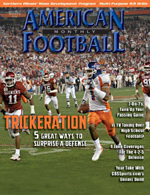Article CategoriesAFM Magazine
|
Strength Report: Northern Illinois’ Mass Development Programby: Eric KleinDirector of Sports Performance, NIU © More from this issue At Northern Illinois University, we believe in the complete development of our student-athletes. Our athletic department motto is “we develop champions in the classroom, in competition, and in life.” I believe it is paramount that when a student-athlete enters our program, upon graduating they will be a better individual in all aspects of society. We coach all aspects of life in our weight facility with strength development only being part of our overall mission.
|
|
|||||||
| HOME |
MAGAZINE |
SUBSCRIBE | ONLINE COLUMNISTS | COACHING VIDEOS |
Copyright 2025, AmericanFootballMonthly.com
All Rights Reserved





